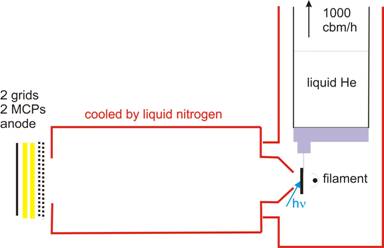Physisorbed Layers
Physisorbed and condensed rare gases are model systems for large band gap insulators. E20 has done pioneering work in investigating bonding, and electronic properties of the surface layers, and the first layers close to the surface of such rare gas solids. Highlights have been the explorations of:
- quantum effects in sticking [Phys. Rev. Lett. 60, 2515];
- electronically stimulated desorption by excitation and decay of excitons [Phys. Rev. Lett. 59, 791];
- excitation and properties of biexcitons, in particular their excitation by a single photon [Phys. Rev. Lett. 66, 3269; Solid State Commun.; Low Temp. Physics 29, 266];
- symmetry related surface effects [Phys. Rev. B55, 9387, Chem Phys. 289, 69], including:
- doubly excited Rydberg series [Phys. Rev. Lett. 74, 3792];
- electron transport through thin layers of rare gases (in co-operation with the groups of W. Wurth, Universität Hamburg, and U. Höfer, Universität Marburg) [Phys. Rev. Lett. 80, 1774; 88, 056805; 89, 046802];
- surface mediated reduction of post collision interaction [Phys. Rev. Lett. 81, 2771];
- thermally and electronically stimulated desorption of physisorbed He monolayers [Phys. Rev. Lett. 89, 126101].
Subjects of all but the last topic have been the noble gases Ne through Xe; He, the lightest, electronically simplest and therefore for theoreticians most interesting noble gas could not be studied due to experimental reasons: The preparation of well defined He adsorption layers requires on the one hand low substrate temperatures in the 1K (for a bilayer) to 2K range (for monolayers) because of the very weak van der Waals-interaction of He, but on the other high substrate temperatures above 1200K for the preparation of clean and well ordered substrate surfaces. This large temperature window and the necessity of perfect ultra high vacuum conditions is a challenge for the experiment. In addition, 300K black body radiation suffices to stimulate desorption [Phys. Rev. Lett. 89, 126101]. Experiments have to be done in a cold environment, therefore. This is the reason why apart from our previous monolayer investigations (see above) no experiments exist so far on the properties of He on well defined metal substrates. To close this gap, we plan a series of experiments:
A novel cryostat has been assembled which grants access to the wide temperature range mentioned above and allows adsorption of more than one He layer. To avoid desorption by black body radiation from the ambient, the environment of the sample including the time-of-flight electron spectrometer is cooled by liquid N2 . In particular the property and ordering of the second layer is of great interest [Syvokon, Low. Temp. Phys. 32, 48]. Two-dimensional electron and particle emission spectroscopy (experimental section) will be used to discriminate initial and final state effects.

Experimental assembly for the investigation of He mono and bilayers. A time-of-flight spectrometer consisting of a drift tube cooled by l-N2 and a MCP stack detects electrons, ions, metastable neutral particles and fluorescence photons.

Oscillator strength distributions for double excitations of He gas measured by electron energy loss spectroscopy, with the deflection angle of the electron beam as parameter. Due to electron correlation, only one of three series is seen for the dipole excitation regime (0° deflection corresponding to negligible momentum transfer; from Xiao-jing Liu et al., Phys. Rev. Lett. 91, 193203).
As yet, the photon energy dependence of stimulated He desorption by infrared radiation has not been studied experimentally: Only theoretical prediction on the wavelength dependence of the desorption cross section exist so far. To close this gap, we plan desorption experiments with infrared radiation of different wavelengths.